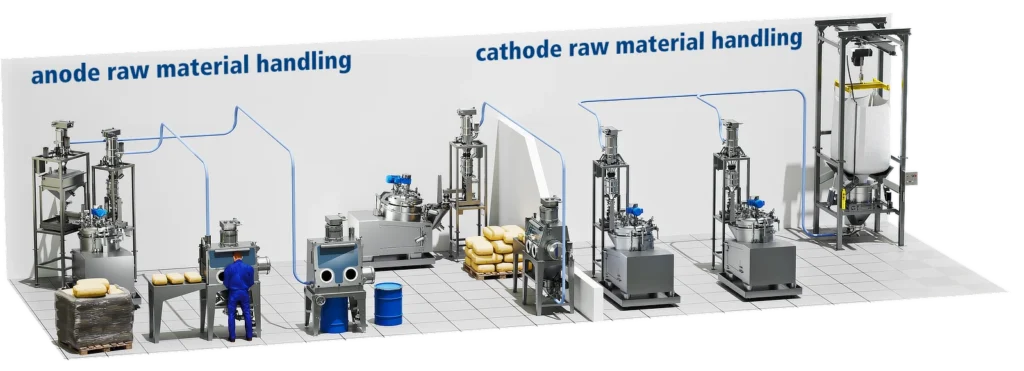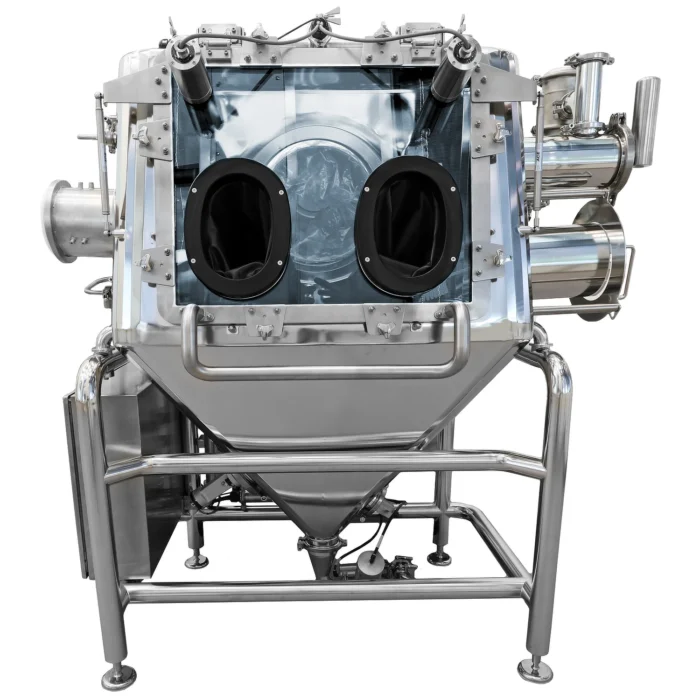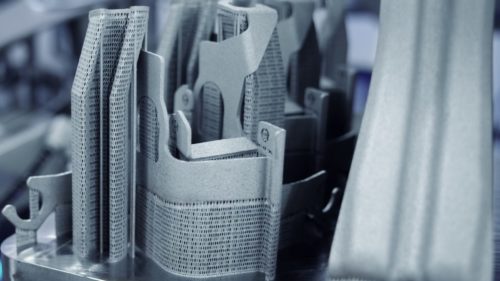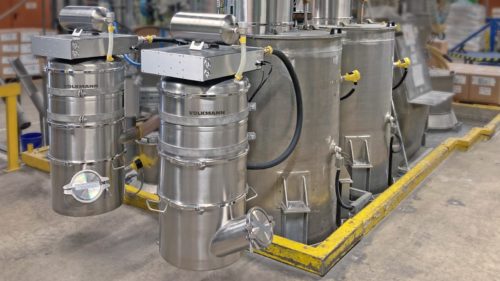Battery production – Handling of Critical Raw Materials
Do you want to safely handle critical raw materials in the production of anode and cathode material? Starting with the removal from the transport container, safely moving the material through to various process systems. Ensuring maximum safety for the product, for the operators and for the environment. For the specific requirements of your project, you need an experienced solution provider who will advise you competently, use proven components, design customised solutions, validate them in trials, and reliably implement them for you. With VOLKMANN, you have found the right partner.
The process starts with the feeding of the material from bulk bags or big bags, drums, bins or sacks into a vacuum conveying system. The material can be conveyed over short or long distances, finishing with the loading of process equipment e.g. a mixer, extruder, container or silo.
![Battery raw materials handling + captions (1600×579) [EN] System for handling critical raw materials for the production of anode material and cathode material. The raw material delivered in sacks and drums is emptied in gloveboxes and fed into mixers by vacuum conveying, weighing and dosing. The material delivered in a big bag is also fed into the mixer.](https://volkmann.info/wp-content/uploads/Battery-raw-materials-handling-captions-1600x579-1.webp)
Bag emptying station
Drum emptying station
Bag emptying station
Mixer, with 2 powder conveying, weighing and feeding systems
Mixer, with powder conveying, weighing and feeding system
Mixer, with powder conveying, weighing and feeding system
Mixer, with powder conveying, weighing and feeding system
Bulk bag (big bag) emptying station
Example of a production area for handling critical anode and cathode material. The material is fed into the processes from bags, drums and big bags. The material is emptied in the corresponding stations and conveyed to the mixers by vacuum conveying through the pipework, weighed and fed into the mixers.
Example of a production area for handling critical anode and cathode material. The material is fed into the processes from bags, drums and big bags. The material is emptied in the corresponding stations and conveyed to the mixers by vacuum conveying through the pipework, weighed and fed into the mixers.
Feeding the Raw Materials
We offer you systems for feeding raw materials from transport containers or packaging into a vacuum conveying system, ensuring safe handling directly into the production process. The raw material can be fed from:
Bulk Bags, big bags or FIBCs
Bags or sacks
Drums, bottles or containers
IBC containers
Our key priorities are:
Efficient and economic operation
Protection of the raw material from contamination
Protection of the operator from the raw material
A containment system hermetically separates the powder handling area from the operator side. This design also reduces the risk of cross-contamination of the product.
This handling is particularly important for toxic and, in some cases, carcinogenic cathode materials such as cobalt, manganese or nickel.
Material conveying
Vacuum conveyors can transport the raw material through a pipe over short or long distances finishing with the loading of process equipment e.g. a mixer, extruder, container or silo. The vacuum conveyors handle the material very gently as there are no rotating or fast moving machine parts involved.
Vacuum is generated by a Multijector® ejector pump, the control system is operated entirely by pneumatics off the compressed air supply, which enables the pump to be used safely in hazardous areas. If required, electric vacuum pumps can also be used. The systems can be scaled from a few kilograms per hour up to 10,000 kg/h. Volkmann conveyors are ATEX approved as standard.
Where required, vacuum conveying can also be carried out with an inert gas (e.g. N2 or argon).
Weighing + Dosing
Dosing for a steady material feed
The conveyed material can be fed into the downstream station – e.g. a mixer – in a continuous material flow. A module consisting of a buffer container and a vibratory feeder is integrated into the system for this purpose. The vacuum conveyor transfers the material to the buffer container at intervals. The vibratory feeder continuously takes material from the buffer container and feeds it into the downstream station.
Weighing the material
The material can be weighed before it is passed on to the next station. When a vibratory feeder is used, the feed quantity can be defined with high accuracy.
Combined weighing and dosing can be realised as a loss-in-weight (LIW) or gain-in-weight (GIW) concept. In the LIW concept, a module consisting of a buffer container, vibratory feeder and the product contained therein is permanently weighed with a load cell, the weight changes are monitored and the vibratory feeder is controlled accordingly. With the GIW concept, the downstream station (e.g. a mixer) is permanently weighed. The value is transmitted to the conveyor system’s PLC via a data interface and the vibratory conveyor is controlled accordingly.
![vacuum conveyor + weighing + feeder (300x1000px) [EN] Combination of vacuum conveying with load cell and vibration conveying for exact weight determination and quantity feed of a specified weight to the downstream machine.](https://volkmann.info/wp-content/uploads/elementor/thumbs/vacuum-conveyor-weighing-feeder-300x1000px-r5ujzmkd514qr8youo76c5ci8tpp3hxjfva0eye96o.webp)
Our engineering solutions for you
We are also able to provide solutions for powder sieving, mixing and to dry powders with vacuum. And, if required, we can manufacture parts that are 100% copper and silicone-free.
For more than 20 years we have been supplying industry-leading systems for handling critical raw materials to well-known battery manufacturers in Europe, Asia and North America. As an industry-leading manufacturer of vacuum conveying systems, we have been a trusted solution provider, to various international companies, for decades. We have often supplied customised and technically sophisticated systems that include WIP/SIP and inert gas blanketing in addition to containment.
Over 90% of our equipment is designed, developed, and produced exclusively at our facility in Soest, Germany, giving us greater control over the whole process. Due to the interaction of our engineering and manufacturing departments, we can supply our customers with a solution adapted to their needs with the highest quality. And with our modern technical and trials centre, fitted with clean rooms, it enables us to carry out tests under controlled environmental conditions.




